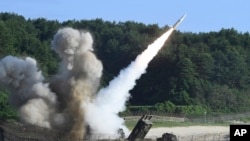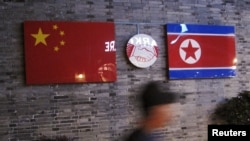Threats from China, Russia and North Korea have fueled debate in Washington about whether the United States should consider redeploying tactical nuclear weapons to the Indo-Pacific region, with leading U.S. Senate members expressing opposing views.
Earlier in May, Republican Senator Roger Wicker, ranking member of the Senate Armed Services Committee, put forward a military spending plan that included the idea of redeploying U.S. tactical nuclear arms that were withdrawn from South Korea more than three decades ago.
Another Republican, Senator James Risch, who is the ranking member of the Senate Foreign Relations Committee, told VOA Korean last month in an email statement that the U.S. should “explore options for returning nuclear weapons to the Pacific theater for the purpose of strengthening extended deterrence."
The term “extended deterrence” refers to the U.S. commitment to respond in kind to a nuclear attack on South Korea.
Drawing a contrast, Democratic Senator Jack Reed, chairman of the Senate Armed Services Committee, told reporters Monday in a phone conference that he didn't think that U.S. tactical nuclear weapons should be redeployed to the Korean Peninsula, adding that it could provoke a “major response from the Chinese.”
Redeployment of nukes
The U.S. government has made it clear that the U.S. does not plan to redeploy its tactical nuclear weapons to the Korean Peninsula.
“We believe that the only effective way to reduce nuclear threats on the peninsula is by curbing the proliferation of nuclear weapons,” a State Department spokesperson said in an emailed statement to VOA last week.
In 1991, the U.S. withdrew from South Korea all of its nuclear weapons, or about 100, according to some studies.
The U.S. has been closely watching the growing military cooperation among China, Russia and North Korea, especially in the wake of Russia’s invasion of Ukraine. It has identified the three nations as threats to stability in the Indo-Pacific region and beyond.
On August 22, the White House confirmed to VOA that a new “nuclear employment guidance” had been issued. The terms of the classified document are not public, but The New York Times quoted two senior administration officials as saying that it “seeks to prepare the United States for possible coordinated nuclear challenges from China, Russia and North Korea."
"The guidance issued earlier this year is not a response to any single entity, country, nor threat,” White House National Security Council spokesman Sean Savett said in an email to VOA. “We have repeatedly voiced concerns about the advancing nuclear arsenals of Russia, PRC [China] and the DPRK [North Korea].”
Vipin Narang, who recently served as the acting assistant secretary of defense for space policy, said in an August forum held by the Washington-based Center for Strategic and International Studies that the United States may need to seek “a change in the size or posture” of nuclear forces to deal with threats from China, Russia and North Korea.
Growing threats
In South Korea, there is growing uneasiness about the U.S. capability to protect South Korea from North Korea’s advancing nuclear and missile weapons.
North Korea’s state Korean Central News Agency on Sunday released a photo showing the country’s leader, Kim Jong Un, inspecting a new 12-axle transporter erector launcher (TEL), which could be used to launch a new, longer missile to potentially attack the United States. The next day, in a speech celebrating the country’s founding anniversary, Kim vowed to increase the number of nuclear weapons “exponentially.”
Amid these geopolitical tensions, U.S.-based experts appear to be divided about whether the U.S. should redeploy tactical nuclear weapons to the Korean Peninsula.
Richard Lawless, former deputy undersecretary of defense for Asian and Pacific security, said the idea that South Korea would be intimidated by China, Russia or South Korea from even beginning a discussion on the subject with Washington “is failed logic.”
“Many Americans continue to fail to appreciate the threat of North Korea and China, typically playing down the latter.”
Robert Peters, a research fellow for nuclear deterrence and missile defense at the Heritage Foundation, told VOA Korean via email that he supported the deployment of tactical nuclear weapons to South Korea.
“I’m concerned about the credibility of our deterrent in the face of North Korean nuclear expansion and Chinese nuclear breakout,” Peters said, adding that stationing nonstrategic nuclear weapons within the theater gives the U.S. president “far more optionality when crafting a deterrence message during times of acute crisis or conflict than if he or she could rely solely on strategic nuclear weapons.”
Opposing views
But Bruce Klingner, a senior research fellow for Northeast Asia at the Heritage Foundation, said he was against redeploying U.S. tactical nuclear weapons.
“Placing such high-value weapons in a static, fixed bunker makes a very tempting preemptive target for North Korea,” Klingner told VOA Korean on Tuesday via email. “During a crisis, it could even lower deterrence by making Pyongyang more likely to initiate a preemptive attack on the bunker prior to the weapons being deployed on mobile launch platforms.”
Gary Samore, former White House coordinator for arms control and weapons of mass destruction during the Obama administration, said he didn't support the redeployment of U.S. nuclear weapons to South Korea.
“From a strictly military standpoint, the U.S. can enforce extended deterrence with nuclear-armed submarines and long-range bombers that North Korea cannot defend against,” Samore told VOA Korean on Tuesday via email.
“Politically, redeployment of U.S. nuclear weapons in South Korea would be controversial with some Korean political parties and the Korean public and would increase tensions in the region, especially with China and North Korea, and even between South Korea and Japan,” Samore said.
Sydney Seiler, who until last year was the national intelligence officer for North Korea on the U.S. National Intelligence Council, told VOA Korean via email Tuesday that “there is a consensus among [U.S. and South Korean] leaders and their senior national security advisers that such a redeployment is unnecessary at this time.”
The Chinese Embassy in Washington told VOA in an email Tuesday that the Chinese “firmly oppose any country’s attempt to use the Korean Peninsula nuclear issue to harm China’s strategic security interests.”
“It is hoped that the U.S. can abandon the cold war mentality and hegemonic logic, adopt a rational and responsible nuclear policy, stop nuclear sharing, extended deterrence, expanding nuclear alliance, and other negative moves, and play a constructive role in maintaining regional and global peace and stability,” Chinese Embassy spokesperson Liu Pengyu said Tuesday in a written statement via email, responding to an inquiry from VOA Korean.


